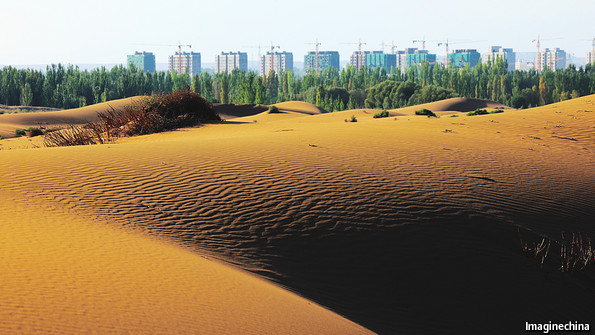Green Means Stop
As of this writing, the Gobi Desert in northern China/southern Mongolia is about half a million square miles (1.3 million km^2) in area. Yes, that’s “as of this writing” — because the Gobi Desert is growing. Due to something called “desertification,” about 1,400 square miles (3,600 km^2) of China’s otherwise arable land is turned into desert each year, as the Gobi creeps further and further south. To make matters worse, winds often pick up the sand, blowing it toward the densely populated areas in China, resulting in immense dust storms. (Here’s a picture of a car windshield after Beijing’s 2006 dust storm season.)
But China is fighting back. With trees.

In 2001, the BBC reported on what has been called, colloquially, the “Great Green Wall,” a not-so-subtle reference to the Great Wall of China, but with trees, as seen above. The wall is part of a decades-long afforestation project which began in 1978 but isn’t expected to be completed until 2050, and which hopes to ultimately make areas currently too arid for habitation or agriculture into fertile homes to both. One of the early phases was a forced participation drive — in 1981, China passed a law which required its citizens over the age of 11 to plant three to five trees each year — but in 2003, the country turned toward government works. The Great Green Wall plan, which went into action that year, called for the creation of a 2,800 mile-long (4,480 km) belt of trees along the Gobi’s border. As Wired reported a year later, this was no small task:
To build the wall, the government has launched a two-pronged plan: Use aerial seeding to cover wide swaths of land where the soil is less arid, and pay farmers to plant trees and shrubs in areas that require closer attention. A $1.2 billion oversight system, consisting of mapping and land-surveillance databases, will be implemented. The government has also hammered out a dust-monitoring network with Japan and Korea.
Whether its working, though, is another question. One Chinese news agency, citing the State Forest Administration, reported in 2007 that “more than 20 percent of the lands affected by desertification in the project areas have been harnessed and soil erosion has been put under control in over 40 percent of the areas that used to suffer soil erosion in the past.” And in 2014, the Daily Mail echoed these results, reporting that “a study says the measures are working, despite previous criticism.” However, that same year, the Economist (via which the image above comes) noted that many of the trees are withering in the dry, hot conditions, and concluded the opposite. And finally, there’s the middle ground, which the BBC reported on in 2011: the afforestation process is working — but it’ll take 300 years to reclaim the lands the Gobi has already taken.
Either way, China intends to push forward. Given its original timetable, they have thirty five years left to figure it out.
 Bonus Fact: Another way China may be able to end up with more trees is by reducing chopstick usage. According to the Washington Post in 2013, China uses between 57 billion and 80 billion disposal wooden chopsticks each year, requiring the chopping down of roughly 20 million trees annually.
Bonus Fact: Another way China may be able to end up with more trees is by reducing chopstick usage. According to the Washington Post in 2013, China uses between 57 billion and 80 billion disposal wooden chopsticks each year, requiring the chopping down of roughly 20 million trees annually.
Take the Quiz!: China is bordered by 14 other nations. How many can you name?
From the Archives: The Isolated Tree: The story of a tree which grew, all by its lonesome, in the Sahara Desert… until it met the most unlikely, untimely end.
Related: Reusable, stainless steel chopsticks. Do your part for $5 or so for a set of five.
